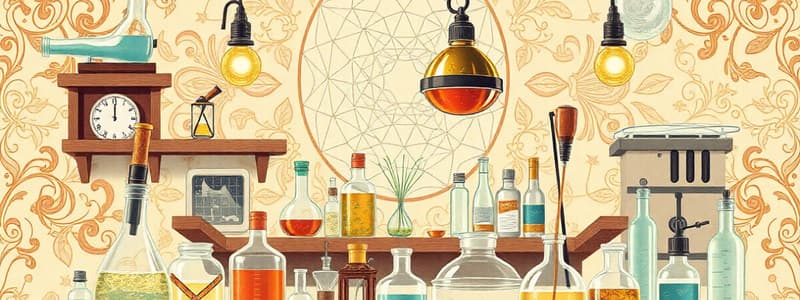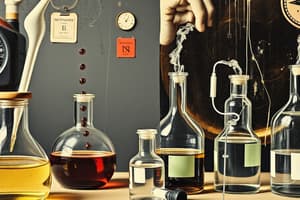Podcast
Questions and Answers
If each character represents a specific data point, and patterns are significant, what preliminary step should be taken before analyzing the 'BB' sequence?
If each character represents a specific data point, and patterns are significant, what preliminary step should be taken before analyzing the 'BB' sequence?
- Examine the immediate context surrounding each 'BB' occurrence. (correct)
- Determine the statistical significance of 'BB' relative to other sequences.
- Ignore 'BB' as it appears to be a random anomaly.
- Calculate the mean occurrence of 'BB' in the entire dataset.
Given the repeated sequence, which analysis technique would best identify non-randomness or periodicity within the data?
Given the repeated sequence, which analysis technique would best identify non-randomness or periodicity within the data?
- Fourier analysis or autocorrelation. (correct)
- Simple frequency counting.
- Chi-squared test for independence.
- Linear regression modeling.
Assuming each line represents a time-series snapshot, how would you interpret changes in the position of 'V' relative to 'M' over time?
Assuming each line represents a time-series snapshot, how would you interpret changes in the position of 'V' relative to 'M' over time?
- The position change signifies a data entry error which needs correction.
- The distance between 'V' and 'M' cannot provide any meaningful information.
- It suggests 'V' and 'M' are inversely proportional.
- The changing distance indicates a shift in the relationship or dependency between 'V' and 'M'. (correct)
If the arrangement represents a rudimentary encoding scheme, what could be a valid approach to decode the information?
If the arrangement represents a rudimentary encoding scheme, what could be a valid approach to decode the information?
If 'S'' represents a critical threshold in a system, and '30' is the measured output, what inference can be drawn?
If 'S'' represents a critical threshold in a system, and '30' is the measured output, what inference can be drawn?
Flashcards
0L
0L
Represents zero liters, a unit of volume measurement.
V
V
Symbol for volume, representing the space occupied by a substance.
M
M
Symbol for mass, the amount of matter in an object.
BB
BB
Signup and view all the flashcards
S'
S'
Signup and view all the flashcards
Study Notes
Laboratory Safety
- Working in a lab is an important aspect of biology study.
- Labs involve hands-on experiments and observations of living organisms.
- This helps in understanding biological principles.
- Labs require safety precautions to prevent accidents.
- Safety guidelines and equipment usage are reviewed for safe lab work.
Pre-Lab Discussion
- Eating or drinking in a lab can be dangerous due to potential contamination by harmful microorganisms.
- Reading through an entire investigation before starting ensures understanding of the work's scope of risks and hazards.
- Safety equipment like fire extinguishers, first-aid kits, eye/handwash stations, and safety showers are essential.
- Proper cleanup procedures should be followed.
- Safety rules should not be skipped to complete work before the bell rings.
- Special symbols in labs indicate activities that demand extra caution; a broken glassware symbol indicates a risk of broken glass.
Identifying Laboratory Equipment
- Scientists use tools to explore the world around them.
- Tools range from simple metric rulers to complex computers.
- This study identifies and explains laboratory equipment (e.g., Bunsen burners, beakers, thermometers, measuring cylinders) typically found in biology/science labs.
Laboratory Equipment - Functions
- Burette: Used for accurately measuring and delivering specific volumes of liquid during titrations.
- Pipette: Precisely measuring liquid volumes and transferring liquids.
- Metre Rule/Ruler: Used to measure lengths.
- Beaker: Used for mixing solutions/heating liquids.
- Thermometer: Used for measuring the temperature of a substance/environment.
- Conical Flask: Used to measure volumes of solutions.
- Bunsen Burner: Used for heating substances directly via a flame.
- Filter Funnel: Used to separate solids from a solution.
- Stirring Rod: For mixing solutions effectively.
- Test Tube Rack: For storing and holding test tubes.
- Test Tube Holder: For holding test tubes while heating.
- Measuring Cylinder: Precisely measuring liquid volumes.
- Forceps: For handling objects during weighing.
- Mortar & Pestle: Used for grinding substances into powder form.
- Dropper/Pipette: For dispensing small volumes of liquids.
- Desiccator: Used for drying substances gradually.
- Beaker: Used for holding, pouring, and measuring liquid volumes.
- Volumetric Flask: For producing solutions with known volumes.
Common Laboratory Hazards
- Physical Hazards: Slips, falls, broken glass, sharp objects.
- Electrical Hazards: Damaged/faulty electrical equipment.
- Fire and Explosion Hazards: Flammable chemicals, open flames.
- Chemical Hazards: Toxic substances (e.g., heavy metals, pesticides, volatile organic compounds), corrosive substances (e.g., strong acids, bases), flammable liquids (e.g., solvents, fuels), reactive substances.
- Biological Hazards: Pathogenic microorganisms (e.g., bacteria, viruses, fungi, parasites), toxins, allergens. (biological substances that cause harm)
Preventing Laboratory Hazards
- Physical Hazards: Clean spills, proper lighting, use of protective gear (gloves, safety glasses, lab coats).
- Chemical Hazards: Proper chemical handling, labeling, use of fume hoods, safe disposal procedures.
- Biological Hazards: Use of personal protective equipment to prevent exposure.
- First Aid: Procedures to handle injuries in the laboratory.
Microscope
- Microscopes are tools that let us view tiny objects.
- Different kinds of microscopes include:
- Dissecting/stereo microscopes
- Compound microscopes
- Electron microscopes
- Photomicrograph Microscopes
- Microscopy is crucial for examining minute details of organisms.
- Microscopy can be used to view cell organelles.
Lab Procedure
- General safety guidelines (PPE/dress code).
- Pre-lab preparations (e.g., reviewing lab procedures and safety protocols).
- Experimental procedure steps.
- Post-lab cleanup procedures.
Common Laboratory Apparatus
- Cleaning, storage, maintenance, and safety protocols involve proper care and handling of equipment.
- Ensure proper training on equipment usage and maintenance.
Studying That Suits You
Use AI to generate personalized quizzes and flashcards to suit your learning preferences.




